
Credit Gap Falls 12.01% - Modi Government Speeds Financial Inclusion
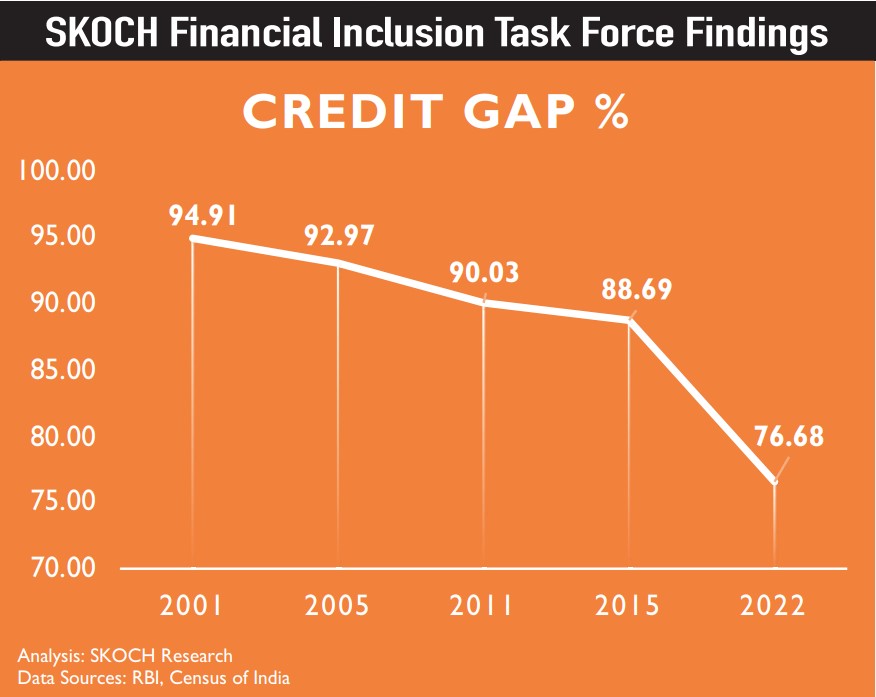
Credit gaps in India declined by 12.01 percentage points in seven years between 2015 and 2022 as against a mere 6.22 percentage points drop in the previous 14 years between 2001 and 2015, showing impressive outcome of the Financial Inclusion initiatives taken by Prime Minister Narendra Modi government, according to a report released by SKOCH Financial Inclusion Task Force ahead of the Union Budget 2023-24.
In 2001, credit gaps in India stood at 94.91 per cent. This declined marginally to 92.97 per cent in 2005 and further to 90.03 per cent in 2011 and 88.69 per cent in 2015. Though there was a consistent decline in credit gap between 2001 and 2015 but the progress was marginal.
| Time Period | Average Rate of Decline in Credit Outreach Gap | Total Decline |
|---|---|---|
| 2001 - 2005 | .51 | 2.24 |
| 2005 - 2011 | .41 | 2.24 |
| 2011 - 2015 | .37 | 1.34 |
| 2015 - 2022 | 2.06 | 12.01 |
Considerable progress was witnessed between 2015 and 2022. During this 7 year period, the credit gap fell from 88.69 per cent in 2015 to 76.68 per cent in 2022, registering a decline of 12.01 percentage points.
Credit gap refers to the proportion of people having no access to formal credit. SKOCH Financial Inclusion Task Force research report on credit gaps uses the same methodology of calculation as used by the Rangarajan Committee in its report released in 2008. A Committee on Financial Inclusion headed by former RBI Governor C Rangarajan analysed credit gaps for the year 2005.
Considerable progress was witnessed between 2015 and 2022. During this 7 year period, the credit gap fell from 88.69 per cent in 2015 to 76.68 per cent in 2022, registering a decline of 12.01 percentage points.
Credit gap refers to the proportion of people having no access to formal credit. SKOCH Financial Inclusion Task Force research report on credit gaps uses the same methodology of calculation as used by the Rangarajan Committee in its report released in 2008. A Committee on Financial Inclusion headed by former RBI Governor C Rangarajan analysed credit gaps for the year 2005.
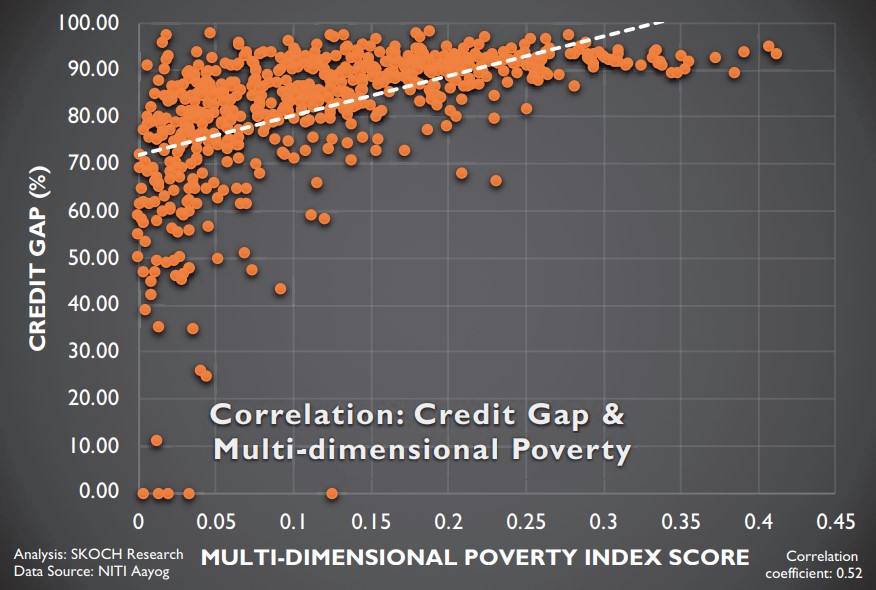
Commenting on the findings of the report, SKOCH Group Chairman Mr Sameer Kochhar said, “Access to credit is one part of the problem. The Task Force will additionally examine the impact of absorptive capacity of the population, something, that did not receive much attention in the past. It is likely that a large number of people are not able to access credit because of lack of absorptive capacity and associated costs.”
He further added, “The significant findings of the report are a positive relationship between growth in credit and growth in Net State Domestic Product (NSDP) and a relationship between growth in credit and reduction in multidimensional poverty.”
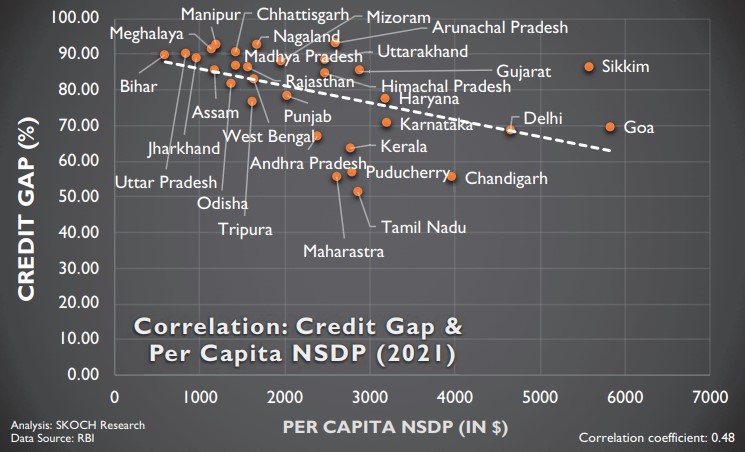
The research report is based on input and analysis of the Financial Inclusion Task Force formed by SKOCH Group. The members of the task force include: Dr Deepali Pant Joshi, Former Executive Director, Reserve Bank of India; Prof S Mahendra Dev, Chairman, Institute for Development Studies; Dr Siraj Hussain, Former Union Agriculture Secretary; Mr Jiji Mammen, Executive Director & CEO, Sa-Dhan; Ms Reema Nanavaty, Director, SEWA; Dr Alok Misra, CEO & Director – MFIN; Mr S S Mundra, Chairman, BSE Ltd; Mr U K Sinha, Former Chairman, SEBI; Mr C S Ghosh, MD & CEO, Bandhan Bank; Dr Amarjeet Sinha, Former Union Rural Development Secretary; Prof Abhiman Das, RBI Chair Professor in Finance & Economics, IIM- Ahmedabad; Mr Sameer Kochhar, Chairman, SKOCH Group; Mr Ajay Thakur, Head, BSE SME; Ms Renana Jhabvala, Chairperson, SEWA Grih Rin Ltd; Ms Jayshree Vyas, MD, Mahila Sewa Sahakari Bank; Dr Deepak B Phatak, IIT-B, Mumbai; Dr Ajit Ranade, VC, Gokhale Institute of Politics & Economy; and, Mr Anil Bhardwaj, Secretary General, FISME.
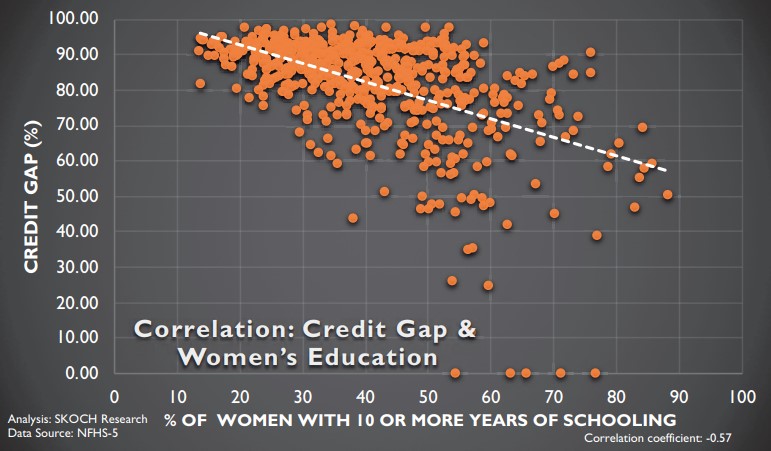
The SKOCH Financial Inclusion Task Force research report reveals wide geographical variations in credit gaps. States/UTs that have witnessed sharp drop in credit gaps include Tamil Nadu, Chandigarh, Maharashtra, Puducherry and Kerala. In Tamil Nadu the credit gaps fell to 51.38 per cent in 2022 from 91.54 per cent in 2001. Tamil Nadu’s performance has been consistently impressive since 2001. Credit gap in Tamil Nadu fell from 91.54 per cent in 2001 to 75.58 per cent in 2011 and further to 62.29 per cent in 2015. On the other hand, the major gains in Maharashtra and Chandigarh were recorded post 2015.
North Eastern states still face acute credit gaps and are struggling to make progress. In Arunachal Pradesh credit gaps stood at 93.17 per cent in 2022 as compared to 96.60 per cent in 2001. The state and union territories where credit gaps are over 90 per cent include Chhattisgarh, Lakshadweep, Meghalaya, Nagaland and Daman & Diu.
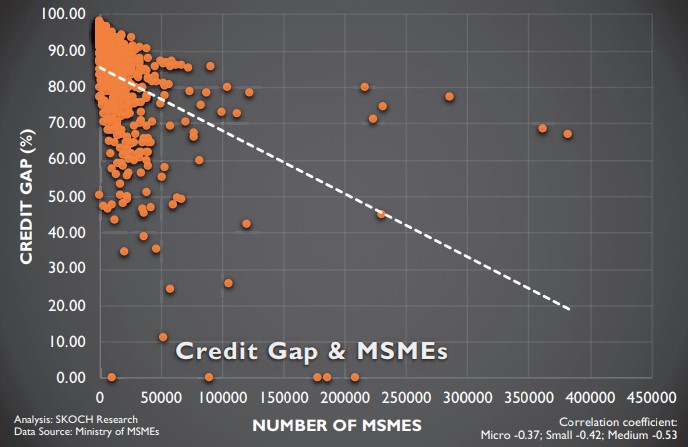
Bihar and Uttar Pradesh also remain among the major drag. The credit gap in Bihar dropped to 89.83 per cent in 2022 from 94.81 per cent in 2015. In Uttar Pradesh, credit gaps dropped from 94.06 per cent in 2015 to 89.95 per cent in 2022. In these two major states the progress between 2001 and 2015 was pretty slow.
The research report also presents district wise analysis of credit gaps. As per the report, 211 districts still face a credit gap of more than 90 per cent.
The report also analyses the correlation between credit gaps and socio-economic indicators including multi-dimensional poverty, women’s education and access to clean fuel for cooking among others.
Terms of Reference
- Articulate credit gaps in both consumption, as well as livelihood linked credit.
- Articulate financial literacy gaps.
- Leveraging the digital infrastructure established since 2014 to fulfil these gaps.
- Identify innovative solutions for making available credit from within and outside the banking system.
- Suggest how digital lending and technology can create universal access to credit.
- Creating newer models of underwriting risk, collateral, credit rating and raising capital.
- Accelerating participation in Markets.
- Introduction of bonds, market instruments and ESG financing for the excluded.
- Other relevant recommendations
Findings Thus Far
- After seeing marginal progress till 2015, the country has made considerable progress since, reducing the overall credit gap to 76.68%.
- While numerous States and Union Territories have made commendable progress since 2004, the North Eastern states are still struggling to make progress.
- The correlation to multi-dimensional poverty outlines how increasing access to credit reduces poverty.
- The correlaiton to NSDP of states shows positive impact of credit.
- Microfinance Institutions haven’t been able to reach districts with acute credit gaps. However, with the removal of interest rate ceilings, they are incentivised to reach hard-to-reach districts with acute credit gaps.
- There is still a lot of progress to be made in making credit more accessible in the country, with 211 districts still facing a credit gap of more than 90%.
- In 2005, the Rangarajan Committee Report had said that 255 districts faced a critical credit outreach gap of 95%. In 2022 that number has gone down to 28 districts.
- While the average outreach gap in 2022 is 76.68%, the average for Aspirational Districts is 88.33%.
- There is a correlation between women's education and access to clean cooking fuel with credit gap.
- Other socio-economic factors were found to be statistically insignificant.

